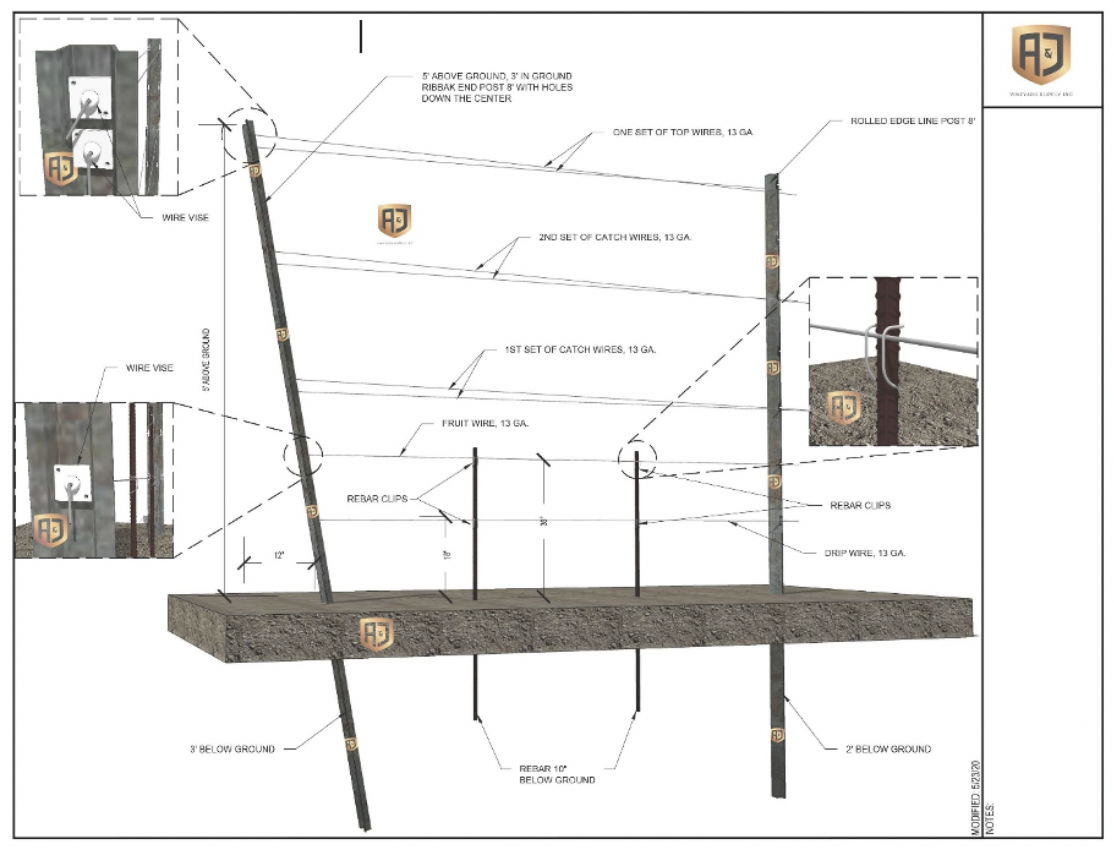Construcción de enrejado 101: Construcción de un enrejado básico de uva de vino

Hay varias opciones disponibles para los viticultores y administradores de viñedos al considerar qué configuración de enrejado y qué sistema de entrenamiento usar. Este blog explora los requisitos básicos para la construcción de enrejados para vino, explicando las herramientas y los suministros necesarios para un sistema de enrejado eficaz, sin importar la configuración que se elija.
Por qué utilizamos un enrejado de uva de vino
Como saben, las uvas crecen naturalmente hacia el sol, abriéndose paso hasta el punto más alto donde pueden robar la mayor cantidad de luz solar disponible. Sin embargo, la tarea de cosechar uvas sería una pesadilla si dejamos que las vides corran libremente. En cambio, un sistema de enrejado de uva de vino ayuda a controlar estas enredaderas de gran alcance para facilitar la cosecha de la fruta. La clave es maximizar el rendimiento de una vid equilibrando la cantidad de desarrollo de la fruta con la cantidad de partes de la vid que producen energía.
Construcción de sistemas de formación y enrejados: herramientas y materiales
Un enrejado básico para uvas de vino consta de 4 partes principales: postes finales, estacas en línea, estacas de entrenamiento y alambre. los publicaciones finales are the longest and most substantial of the main components, generally ranging from 8’ to 10’ in length. With one end of the post buried several feet underground, the end posts serve to anchor the vine rows at each end and therefore provide the start and end of the row as well as the general trajectory, with the full length of each row equaling the distance between the end posts.
Apuestas en línea, typically 7’ to 8’ in length, serve as intermediate supports along the vine row. Less substantial in height and weight than the end posts, yet still sturdy enough to support the weight of numerous vines on either side, once installed the in-line stake establishes the approximate trellised height of the mature vineyard as well as providing a point of attachment for the drip, cordon, and canopy management wires.
Estacas de entrenamiento are significantly shorter (typically 4’ to 5’) and lighter and are installed at equal distances between the end posts, adjacent to each vine. As their name would suggest, they are required in a new vineyard to serve as a guide for young vines, helping to ensure that their initial growth is straight and supported. This is accomplished by tying the new growth to the training stake using any number of different tying methods and materials. A vine protector or “grow tube” También se puede colocar alrededor de la nueva vid y asegurarla a la estaca de entrenamiento para brindar protección adicional contra el clima y / o criaturas que quieran alimentarse de hojas tiernas. Finalmente, la estaca de entrenamiento también sirve como un punto de sujeción adicional para cables de goteo y fructificación.
Alambre de viñedo is the last of the main components that make up a winegrape trellis. The majority of commercial growers in the United States use hi-tensile, galvanized wire to support and manage their vines within the trellis. Different gauges or thicknesses of wire, typically between 10 – 14, provide different levels of support and different adaptability to certain tasks. The heaviest wire is generally used as the cordon or fruiting wire to support the branches that will bear the heavy, mature grape clusters. Growers who want to suspend their drip line off the ground and keep it from sagging throughout the row commonly use the lightest gauge wire to accomplish this task. Intermediate thicknesses are often used in pairs as moveable catch wires to “catch” and trap the vine’s foliage between the wires. The wires are then moved up the in-line stake as the vines’ shoots become longer. Vineyard wire is sold in smaller coils of 100 pounds each or in longer, continuous coils ranging from 500 – 2,000 pounds per coil. These longer coils make working in very long vineyard rows more efficient.
Estilos de enrejado de uva de vino
In today’s viticultural environment, there are many different styles of trellis. Growers and vineyard managers often debate which system is the best or most effective. Many adaptations can be made to accommodate the needs of different varietals, the orientation of the rows, the percentage of the slope of the vineyard, and numerous other unique conditions. But no matter what style of trellis system you choose, it will likely include the four basic elements described above. And if properly maintained, it will certainly result in higher yields and better-quality fruit than your non-trellised neighbors.
A&J Vineyard Supply puede ayudar
A Suministro de viñedos A&J llevamos una línea completa de postes finales, estacas en línea, estacas de entrenamiento y cables. ¿Necesita hacer un pedido? Contáctenos aquí o llámanos al 707-963-5354.
